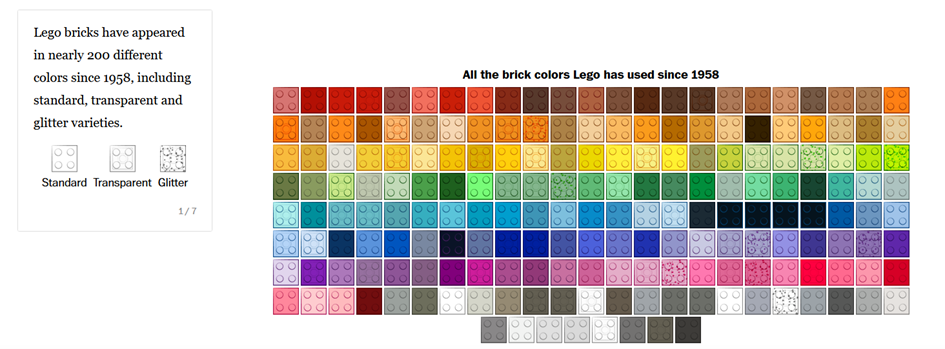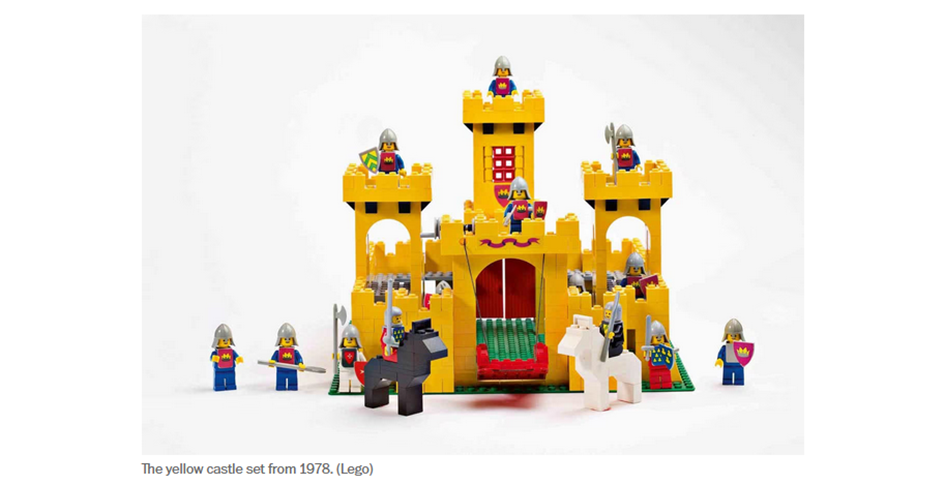Kati Perry Sept. 14 at 3:32 p.m, Washington Post
Since modern Lego bricks debuted in 1958, their color scheme has undergone a transformation from just a handful to more than 110 at the peak in 2004. The palette has evolved, grown and shrunk over the decades.
When Lego started manufacturing bricks, it started small, colorwise. “These were very basic colors,” said Signe Weise, a corporate historian at Lego. The original brick colors, according to Weise, were red, yellow, blue, white and transparent.

If you counted every brick produced since 1958, most would be black, gray or white, but such a census obscures the colorful history of the palette. Using data from Rebrickable, a site that crowdsources information about Lego sets, The Washington Post analyzed the palette to explore what the color system says about the evolution of the company.
Jared Hinton, a Los Angeles-based site administrator for Rebrickable, has worked for more than five years helping to carefully catalogue and maintain the data.
“As the internet and interest in Lego colors has grown, so has our ability to preserve this information and create more accurate inventories,” Hinton said.







A more controlled color palette means designers have to work creatively within Lego’s color system, said Weise. One way designers do that is by reimagining pieces with new colors. For example, a frog piece appears in a bonsai tree set — but pink. The set contains many pink frogs, which sit on the branches of the tree in bloom, giving the appearance of flowers.
Similarly, an Avatar set includes turquoise bananas and purple carrots to build plant life. “You have to find new ways of using old things,” said Weise. “We’re making sure that [the bricks] are within the system and that they fit together with everything we have been doing.”

Themes widen the palette
Beginning in the 1960s, Lego grouped its products into a handful of categories, but it wasn’t until 1978 that Lego debuted the first major themes — Castle, Town and Space. Those themed sets form what is known to fans as the “classic three,” according to Hinton.

These themes each had a palette based on the colors of the time — early Castle sets included mostly yellow bricks while Town included a lot more white and red.

As Lego’s color system evolved and grew, so did the possibility for distinctive palettes. Among the themes that Lego launched in the 1990s were Star Wars and Belville, a category with elements including playgrounds, horses, castles and princesses. Both needed very different color profiles.

“There was this trend of pink toys [in the 1990s],” said Erica Weisgram, a professor at the University of Wisconsin at Stevens Point who researches gender development in children. “Pink got to be a designation of femininity.”
After the introduction of the pinks and pastels in the 1990s, the darker colors and primary colors in Lego’s palette seemed a lot more masculine by comparison, according to Weisgram.
Lego sets are still seen as gendered among parents. In a study commissioned by Lego and conducted by the Geena Davis Institute, researchers found that in an implicit bias assessment, 76 percent of parents said they’d recommend Lego for their sons compared to 24 percent who said the same of daughters.
In that same study, researchers shared recommendations — including about color — to help make Lego products more gender-neutral.
“Palette is a really important way that who a toy is for is communicated,” said Lisa Dinella, a professor at Monmouth University who studies children’s toy play along with gendered experiences. “Our science is really clear that children and consumers notice the color palettes, and that they know that those color palettes are associated with particular genders.”
In 2021, Lego committed to making its toys more gender-neutral.
Lego minifigures and representation
The introduction of themes also marked the first time a Lego set included the yellow minifigure. The yellow minifigure introduced in 1978 was intended to be “ethnically neutral,” according to a Lego account of the history of the minifigure, and for decades almost all were yellow.
That changed in 2003 when Lego released a minifigure for Lando Calrissian, a Black Star Wars character. In that same account, authors write that he was the first minifigure in the Star Wars theme and among the first of all minifigures with natural skin tones.
Star Wars minifigures for human characters — like Luke Skywalker, for example — had been yellow up to that point. The decision to make Lando Calrissian’s skin brown was controversial among fans, according to Hinton, because the introduction of a Black minifigure in a world of yellow minifigures suggested that all yellow minifigures actually represented White skin tones.

Lando Calrissian was not the only minifigure released in 2003 with natural skin tones. That same year, Lego also released minifigures for several real-life people, including NBA stars Kobe Bryant, Chris Webber and Steve Nash. In 2004, Lego released a new color for light skin and updated minifigures in various franchises with natural skin tones.
“It’s important for us because using different colors, especially when we talk skin tones, is what enables us to represent more people,” said Weise. “More people, more children and more adults feel represented in our sets.”

Lego recently cited a desire among kids to see themselves better represented in their toys, which inspired a launch of a new set of characters for Lego’s Friends theme.
“Representation is always a really good thing for kids to be able to see. They want to see themself in the commercial. They want to see themself in this toy,” said Weisgram.
“Even though we have grown and the color palette has grown with us, we still know where we are coming from and what we’re going to stick with to keep the success going as well,” said Weise.
About this story
All of the data used for this story comes from Rebrickable. Modulex colors are not included in the analysis. To calculate the median number of colors used in a given time frame, all Lego pieces were included. Data pulled on Sept. 13.
Rebrickable provides data on Lego sets, parts, themes and colors to help users build new designs with Lego bricks they already have at home. A team of administrators works to ensure the data is as reliable and accurate as possible for their more than 850,000 users. Because the data is crowdsourced, however, it’s not a perfect reflection of the company’s many products over the years.
Kati Perry’s favorite toys growing up were Lego bricks. She was particularly fond of the Harry Potter theme, and now has multiple sets in her home, including two from the Botanical Collection.
Chiqui Esteban edited this story. He grew up with a wooden box full of loose Lego and Tente (a Spanish construction toy similar to Lego) bricks. Bricks from the two brands couldn’t be attached together, so the last piece he needed to finish a ship or car he was building was usually of the wrong system and wouldn’t work.
Anne Kenderdine copy edited this story. She attended the early days of BrickFest but once failed a quiz given by her daughter on identifying the Lego Friends’ characters.
